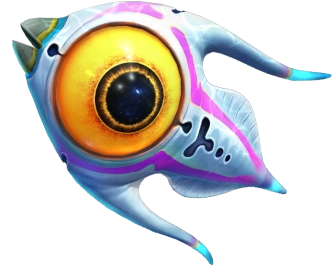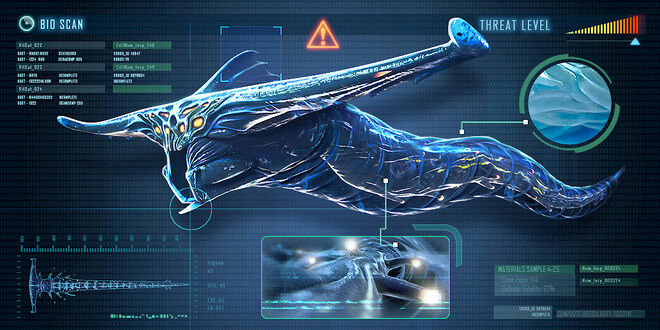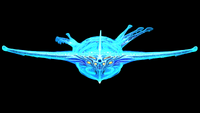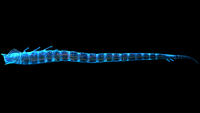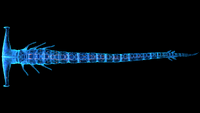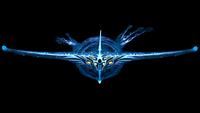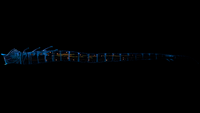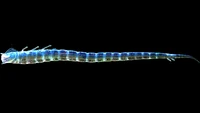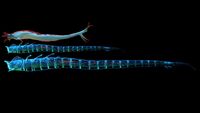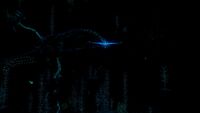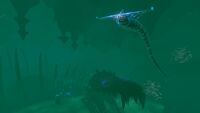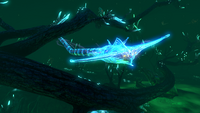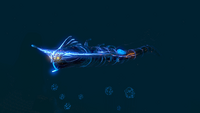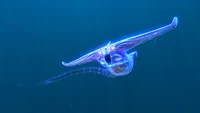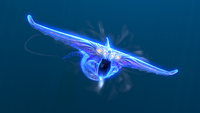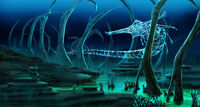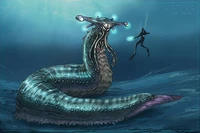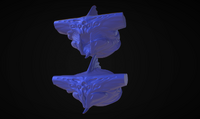Template:Class 2 FaunaThe Ghost Leviathan is a leviathan class life form belonging to the fauna category. It is the second largest aggressive creature of Subnautica, and the third largest creature in the game.
Six Ghost Leviathans spawn on the map: three juveniles in the Lost River, two adults in the Grand Reef, and one adult in the Northern Blood Kelp Zone.
If the player enters the Crater Edge, a single Ghost Leviathan spawns in. If the player stays in the Crater Edge for thirty seconds, a second Ghost Leviathan will spawn. If the player stays in the area for another thirty seconds, a third and final Ghost Leviathan spawns in. They will all pursue the player until the player returns to the playable area, upon which they will all retreat.
The Giant Cove Tree is the nesting ground of this leviathan species (although they are not present around the tree), with its massive glowing bulbs being their eggs. According to PDA scan entries of the Cove Tree, the eggs were laid there when the tree was small, and it has grown around the eggs to protect them until conditions are right to hatch. The Ghost Leviathans' life cycle begins in the Lost River, as juveniles. As the leviathans mature and become too large for their home, they migrate to the open, surface world biomes such as the Grand Reef and Blood Kelp Zone, until eventually migrating to the Dead Zone, continuing to grow and roam freely in the open water.[1][2] Despite being much smaller than the Sea Emperor Leviathan, its eggs are far larger.
Appearance
The Ghost Leviathan has a soft, transparent outer membrane covering a muscular, blue, inner body which features many darker blue stripes, four yellow, bioluminescent eyes as well as six, possibly vestigial fins on the torso section. A small, decorative sail sits on top of the head, and two long structures protruding from either side of its head which bear similarities to the blades of a hammerhead shark. It has a rectangular mouth with a glowing barbule lure beneath. Its long body tapers to a point.
The outer body is transparent, making the smaller, inner body visible. The inner body is long and thin, and covered in pulsating, bioluminescent orange stripes with many orange tipped protrusions ending with blinking bioluminescent orange glows. Unlike the outer body, the inner body has a distinct, thin neck joining the head and body. As the leviathan moves through the water, it leaves trails in the water behind it.
Behavior
To attack a target, it will spiral up and charge. When charging, it will open up its mouth and make a loud, echoing screech. If it successfully attacks, it will do 85% damage to the player and swim some distance away, as if losing interest.
Sounds
Data Bank Entries
|
This creature is approaching the size limit for sustainable organic lifeforms, and has been designated leviathan class. Adults of the species have been encountered exclusively around the edges of the volcanic crater which supports life on this part of the planet, and react with extreme aggression on approach.
Assessment: Extreme threat - Avoid the crater edge |
|
This large predator has adapted to live in deep waters and dark cave systems, attacking anything and everything in its quest to grow larger.
Assessment: Avoid |
Gallery
References
- ↑ http://imgur.com/pqiy0N6
- ↑ http://imgur.com/8QBPgcc Dated July 6, 2017.
| Fauna living within the Crater | |
|---|---|
| Carnivores | |
| Herbivores | |
| Scavengers & Parasites | |
| Leviathans | |
| Extinct | |
| Other Entities | |
